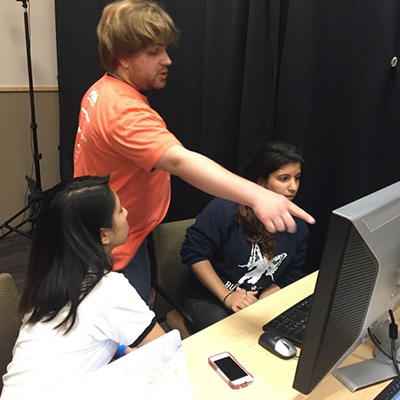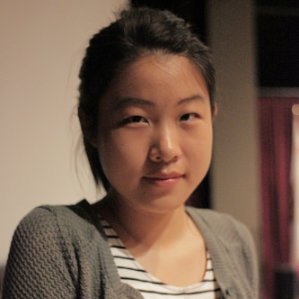
In early June, UC San Diego staged a hackathon, HackXX, for young women, most of them students in computer science or computer engineering at UC San Diego. According to organizers, only 20 percent of hackathon participants are women, and they wanted "to build a welcoming environment to encourage women to build cool things.”

organized HackXX.
Computer science sophomore Kaylie Lu, who had previously helped organize the SD Hacks hackathon in 2016, heard about a women’s hackathon at USC, and together with friends decided to mount a similar effort at UC San Diego to empower women. “I think everyone feels uncomfortable when they are the minority in a field, and I think a women’s hackathon made women feel more comfortable working on tech projects, rather than at a regular hackathon, where they would only make up 20 percent of the population,” Lu told The Triton, an independent campus student newspaper.
CSE Associate Teaching Professor Christine Alvarado agrees. “I think this event is particularly important for UCSD to give our women students a chance to participate in the hackathon culture in an environment where they comprise the majority culture,” said Alvarado, who is also quoted in The Triton. “The most important aspect in achieving gender balance in computing is the culture of the department, and a large part of this is driven by the students themselves.”
Alvarado believes that events such as HackXX can help make hackathon culture more inclusive.

Kristin Agcaoili
One of CSE’s recent faculty hires, Assistant Professor Ndapa Nakashole, participated as a judge for the hackathon, together with CSE alumna Sarah Guthals (Ph.D. ’15), who co-founded the computer-science training company ThoughSTEM and is now affiliated with UC San Diego’s Education Studies department. The panel of judges also included computer-science undergraduate Kristin Agcaoili, an officer of the student-run Virtual Reality Club, which helped to organize the HackXX event.
The top prize at HackXX went to the team behind a fantasy virtual-reality app called Escape from Wonderland, which involved finding a way out of a locked room decorated with images from the classic Alice in Wonderland. It was the first 3D VR program attempted by team members Maggie Chan and two freshman students, computer engineering major Yimeng Yang, and computer-science major Joyaan Bhesania.

of first-place team behind Escape from Wonderland.
Click here to watch 1-minute VR video clip.
“I wrote the scripts for this project and learned how to deal with the components and make them active or inactive,” said team member Yang. “I also learned how to manipulate them to simulate growing and shrinking” in keeping with the Alice in Wonderland theme.
“It was our first time developing a VR project and it took time to learn Unity and C#, but fortunately, we got a lot of help from mentors,” the team noted on their DevPost hackathon diary. “It was just a 24-hour hackathon and we are really proud of what we have accomplished.”
While the competition was restricted to teams of women, a number of men volunteered to be mentors, and to teach tutorial workshops on Unity, VR, and web development. Many of them had experience from SD Hacks, or as members of the student-run Virtual Reality Club that recently helped organize a virtual-reality hackathon in connection with the Center for Cyber-Archaeology and Sustainability (CCAS). The chief mentor for the first-place team behind Escape from Wonderland was fellow undergraduate Connor Smith, president of the VR Club and a frequent participant in hackathons, who also co-organized the Cyber-Archaeology VR Hackathon.
The second-place hack at HackXX was produced by a team of ECE students, including computer-engineering sophomores Jocelyn Tran and Michelle Yang, and electrical-engineering freshman Si Wu, for their program, Sunrises. The system connects a temperature sensor to an Arduino and ultimately to a FireBase for storage to measure a user’s natural body temperature (once per second) to let the user know “when you’re about to menstruate.”
The third prize went to computer science and math graduating senior Linda Wogulis (B.S. ’17), biomedical engineering senior Alice Yepremyan (B.S. ’17) and physics alumna Ayat Amin (B.S. ’16), who minored in computer science. They created the Sustainability Image Classification program. The application takes a webcam image of an object, runs it through an image classification model trained by the students to determine what the object is, and searches a database of recyclables to determine if the object is recyclable or not. “Our trained image classification model is a convolutional neural network that we trained ourselves using Google photos,” the team reported on their DevPost page. “The biggest challenge we ran into was reliably getting the computer to recognize different objects.”

blocks in foreground and zen-like 3D background. Watch
video of Zenga in action.
In addition to the top three prizes, sponsors provided awards for the best beginner’s hack (to a ride-sharing platform called Whereto), and Northrop Grumman's Excellent UX Design Challenge, which went to the team behind a VR game called Zenga: The Zen of Jenga, in which the player manipulates virtual blocks like in Jenga against a VR landscape produced by merging together free components from the asset store. “I worked on the terrain/background of our game,” said team member Regina (Redgy) Canos, “and I’m most proud of the waterfall.” Her teammates included Christina Mak, who is graduating this month with a B.S. in Computer Science from UC San Diego.
Read the original article in The Triton.
Related Links
HackXX
DEVPOST for HackXX
Escape from Wonderland
Sunrises
Sustainability Image Classification

